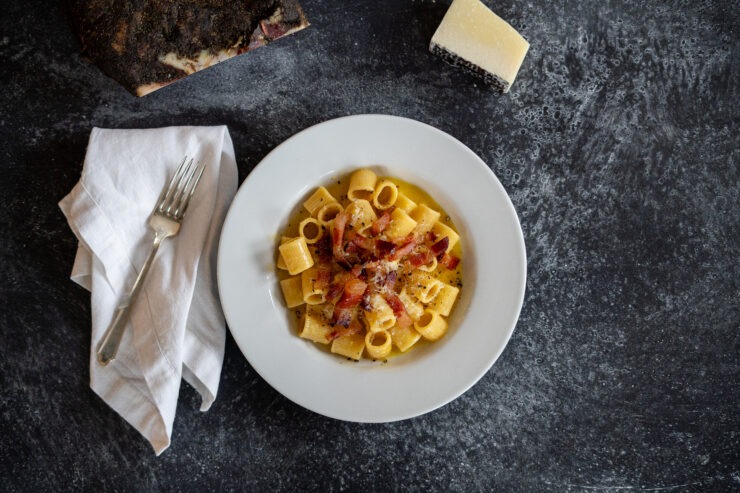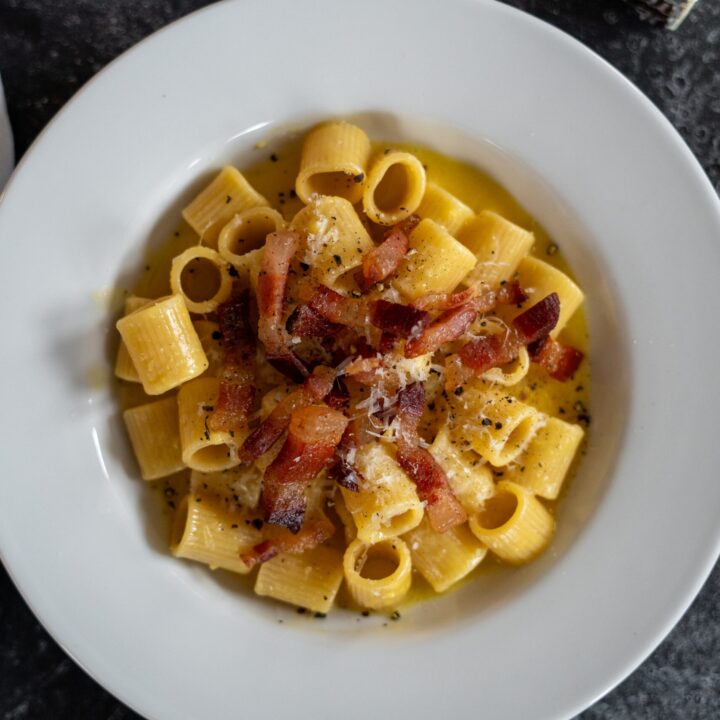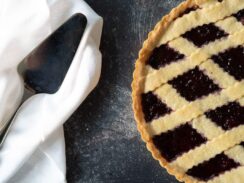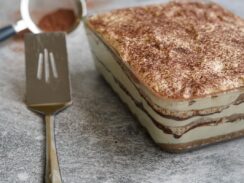Carbonara

Not wanting to venture out to the market in the downpour, mezzemaniche alla carbonara was our choice for lunch on this stormy Sunday afternoon. Pasta, eggs, guanciale, and pecorino romano are staples in our kitchen, and a quick carbonara made for a comforting lunch that diverted our attention from the dark, thundering sky outside.
There are differing theories about the origin of the carbonara’s name. Some say that it was a preferred dish of Italian coal miners (carbonai, or carbonari in romanesco dialect) because of the non-perishable nature of the dry pasta, guanciale, and pecorino, and the availability of fresh eggs from the hens that they kept in their yards.
Others maintain that the recipe appeared shortly after the 1944 Liberation of Rome by American forces – a combination of Italian pasta and the bacon and eggs preferred by North American troops.
Many unauthentic versions of la Carbonara are around. We’ve seen aberrations that include everything from Parmigiano, cream, garlic, pancetta, wine, and more. It’s blasphemous! An authentic carbonara has only five ingredients: pasta, guanciale, egg, Pecorino Romano, and black pepper. The technique is key – you want the eggs to be creamy, not scrambled. It takes practice, but the result is so very worth it.
Spaghetti alla Carbonara is one of the classic dishes of Rome, so it is fitting that we paired it with Fontana Candida, a dry white wine from Frascati, one of the hill towns surrounding Rome that make up the Castelli Romani. Fontana Candida is a refreshing, minerally wine with a crisp acidity and green apple and citrus flavors.

La Carbonara
Many unauthentic versions of la Carbonara are around. This one, though, is just like what you’d find in a Roman trattoria. The trick lies in the authenticity of the ingredients and the technique.
Ingredients
- 1 package spaghetti
- 100 grams guanciale
- 6 eggs (5 yolks and one whole egg)
- 3 cups grated Pecorino Romano, + extra for garnish
- Salt
- Black pepper
Instructions
- Bring a large pot of water on the stove to rolling boil. When ready, toss a heaping handful of salt in the water and add the spaghetti.
- Set a timer for three minutes short of the suggested al dente cooking time specified on the package.
- In the meanwhile, slice the guanciale into strips 1/4″ thick, and then cut again into small pieces.
- In a large saucepan, slowly fry the guanciale, letting it sweat until crisp on the outside and tender on the inside. When done, remove from heat, remove the guanciale and set aside, but leave the oil in the saucepan.
- Separate the yolks from the whites of 5 eggs. Place the yolks into a dish, and discard the whites. Add one more whole egg to the yolk mixture, and beat by hand. Set aside.
- Add the Pecorino Romano to the egg mixture and stir until well-mixed and creamy, not runny. If it is still runny, add more Pecorino Romano. Set aside.
- When the spaghetti are three minutes shy of al dente, remove them from the boiling water with kitchen tongs and add them directly to the saucepan with the oil from the guanciale. Preserve the pasta cooking water.
- Mix quickly and vigorously over medium heat until coated with the oil.
- Add a ladle of the pasta cooking water and continue to stir vigorously.
- Add the egg and Pecorino mixture and continue to stir quickly until the a creamy sauce is formed, adding more cooking water if necessary.
- When the carbonara is ready, transfer the spaghetti to pasta plates. Top them with the guanciale and a generous sprinkling of Pecorino Romano.
- Serve immediately.
Notes
Although spaghetti is the pasta traditionally used for carbonara, it's not uncommon to find rigatoni alla carbonara on the menu in Roman eateries. Some say rigantoni are preferred because the creamy carbonara sauce works its way into the inside of the rigatoni. We've wondered if rigatoni are simply easier for the tourists to eat. Either way, rigatoni are worth a try. Let us know what you think!


Bao
Cara, I just made it for dinner and I love it!!! Simple pasta to make and delicious! I love that it requires so little ingredients! I am always looking for recipes where I don’t have to go buy ten thousand things I don’t already have in my kitchen. I went shopping for the stuff and thought to myself, “That’s it? Am I missing anything?” Thanks for the easy recipes! I am going to try everything!
duespaghetti
That’s wonderful, Bao! Congratulations on being the first to try a recipe and let us know how it worked. La Carbonara is a classic recipe from the city of Rome – you’re an honorary Roman once you’ve made that dish. Your toga is in the mail.
Bridget
Hi Cara & Stefano,
I FINALLY made this recipe after Ethan bugging me for months to do so… It was simply (literally!) fantastic!
Salut,
Bridget
duespaghetti
Wonderful! We are so glad that you gave it a try and that it met Ethan’s approval! There was no doubt in our minds, as both Sean and Ethan have spoken highly of you as a cook.
Paolo (@quatrofromaggio)
Perfect recipe and great background information! I posted a Carbonara-inspired vegetarian pasta on my blog, and I linked to this page for the authentic recipe. Thanks for being such a wonderful reference!